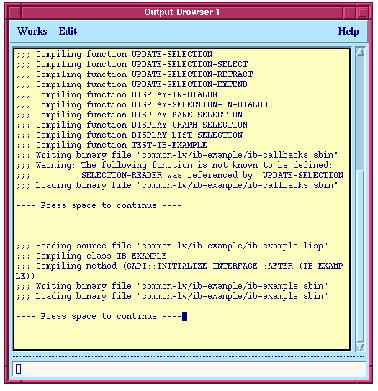





Common LispWorks User Guide, Liquid Common Lisp Version 5.0

Figure 10.1 Output browser
The output browser has one main area which displays any textual output from the environment. The menu bar contains the standard Works and Edit menus, as described in Chapter 3, "Common Features", and a Help menu, as described in Chapter 4, "Getting Help". This mainly consists of compilation, and macroexpansion messages produced by the editor, but can also include output from other tools, such as the tracer.
The main area in an output browser is actually an editor window, so all the usual editor keyboard commands can be used in it. See Chapter 8, "The Editor" for more details about these operations.
The output browser is invaluable when you are developing code, because it can be used to collect any output generated by your code. An example of how to do this is given in Section 2.4 on page 23.
Many other tools in the environment contain an output view, which can be displayed by choosing View > Output from the relevant tool. This view is used to collect all the output which has been generated by that tool. For instance, the listener has an output view that displays all the output from forms evaluated in the listener, and the editor has an output view that collects any output generated by the editor, such as compilation messages or macroexpansions. Note that the output browser is the only tool which, by default, collects any output from your own code.





Generated with Harlequin WebMaker